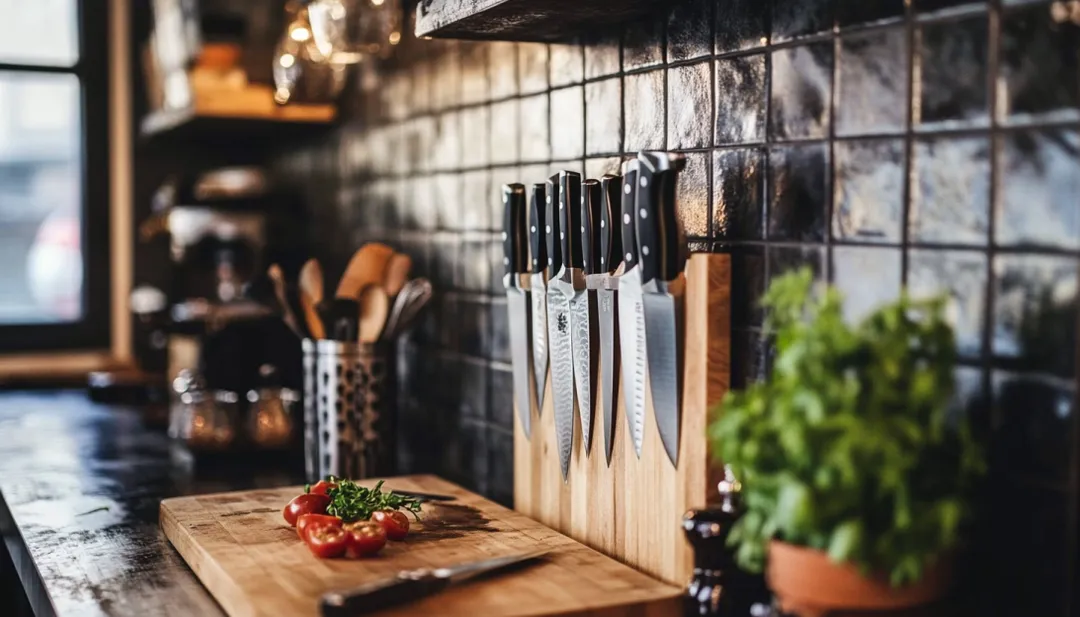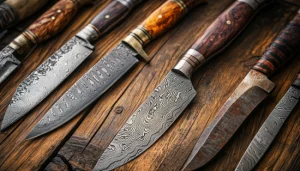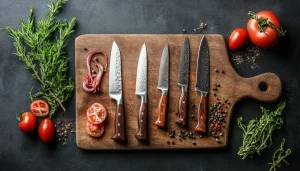Whether you’re a seasoned professional or an enthusiastic home cook, the right knife can make all the difference in your culinary experience. In fact, every chef will tell you that having a well-rounded knife collection is the foundation of any great kitchen. But with so many options on the market, it can be overwhelming to figure out where to start. That’s why we’ve put together this guide on the 3 knives that are essential for a chef, helping you craft amazing dishes with ease and precision.

1. The Classic Chef’s Knife – The All-Purpose Workhorse
When discussing knives which could be essential for a chef, the first and most important is of course, the chef’s knife! This is often referred to as the “workhorse” of the kitchen, and for good reason. With its versatile 8 to 10-inch blade, the chef’s knife is capable of handling most of your cutting, chopping, and slicing tasks with ease.
Why It’s Essential For Chef’s?
- Versatility: From mincing garlic to slicing through thick cuts of meat, a chef’s knife can tackle nearly any task.
- Comfort: The wide blade allows you to use a rocking motion, which makes it easier to chop quickly without sacrificing accuracy.
- Durability: A well-made chef’s knife will last for years, making it a solid investment in your kitchen tools.
In essence, if you were to only invest in one knife, this should be it. The chef’s knife is perfect for both small and large tasks, saving you from switching between multiple blades as you prep. Invest in a high-quality chef’s knife, and you’ll immediately notice the difference in your food prep efficiency.
Chef Knife Example: Mac Professional Hollow Edge 8″ Chef’s Knife

The Mac Professional Hollow Edge 8″ Chef’s Knife is a standout option for both home cooks and professional chefs seeking a versatile, high-performance tool. Crafted by the reputable Japanese brand Mac, this knife blends the best of both Western and Japanese culinary design, offering a hybrid style that provides exceptional sharpness, balance, and comfort.
Unmatched Performance and Versatility
This chef’s knife excels in all aspects of kitchen tasks, making it a favorite among culinary enthusiasts. Its razor-sharp edge glides effortlessly through food, producing paper-thin slices with precision. The lightweight design allows for nimble, controlled movements, reducing hand fatigue even during prolonged use. The knife is perfectly suited for a variety of tasks, from finely dicing onions to slicing delicate tomatoes without crushing them. The hollow edge dimples on each side of the blade reduce friction, preventing sticky foods such as potatoes, apples, and squash from clinging to the blade.
Superior Blade Construction
The MTH-80 model is crafted with molybdenum high-carbon steel, striking a balance between the durable nature of Western-style knives and the sharpness typical of Japanese blades. This unique alloy enhances rust resistance while maintaining an exceptional sharpness. However, due to its high carbon content, the knife is slightly more susceptible to stains and rust compared to stainless steel blades, and its hardness makes it prone to chipping. Proper care and maintenance, such as regular honing and hand washing, are recommended to keep the knife in optimal condition.
Thoughtful Design Features
- Blade Length: 8″ (7.88″ cutting edge), the most popular size in both home and professional kitchens.
- Blade Thickness: 2.5 mm, offering a delicate balance between agility and durability.
- Weight: 6.5 oz, lightweight for easy handling yet sturdy enough for precise cuts.
- Blade Shape: A hybrid design that merges the rounded edge of Western knives with the straighter profile of Japanese models.
- Double Bevel (50/50): Sharpened at equal angles on both sides, making it easy to maintain.
Comfort and Balance
The well-balanced bolster and blade weight create a natural, central balance in your hand, allowing for minimal effort while cutting through various foods. The ergonomic handle ensures a comfortable grip, suitable for extended kitchen sessions.
Mac Professional Hollow Edge User Impressions and Reviews
This knife consistently receives high praise for its performance and quality:
- Users are impressed by its extreme sharpness and agility, often comparing it favorably to other premium brands like Henckels and Wusthof.
- It maintains a sharp edge for extended periods, although some users noted that initial sharpening or maintenance may be required for the best performance.
- Customers appreciate its lightweight yet sturdy feel, which enhances control and reduces fatigue.
- Versatile and multipurpose, it’s the go-to knife for daily tasks, from slicing tomatoes with precision to easily dicing onions.
- Reviewers highlighted the excellent customer service from suppliers, adding to the overall positive experience of purchasing this knife.
Considerations and Drawbacks
While the Mac Professional Chef’s Knife is celebrated for its design and performance, there are some considerations to keep in mind:
- The high carbon steel makes it prone to rust and stains if not properly maintained. Hand washing and drying immediately after use are recommended.
- Its hardness and thin blade contribute to a sharper edge but also make it susceptible to chipping, especially if used on hard surfaces or bones.
- Some users felt that the handle could be slightly larger, and a few preferred a longer blade option.
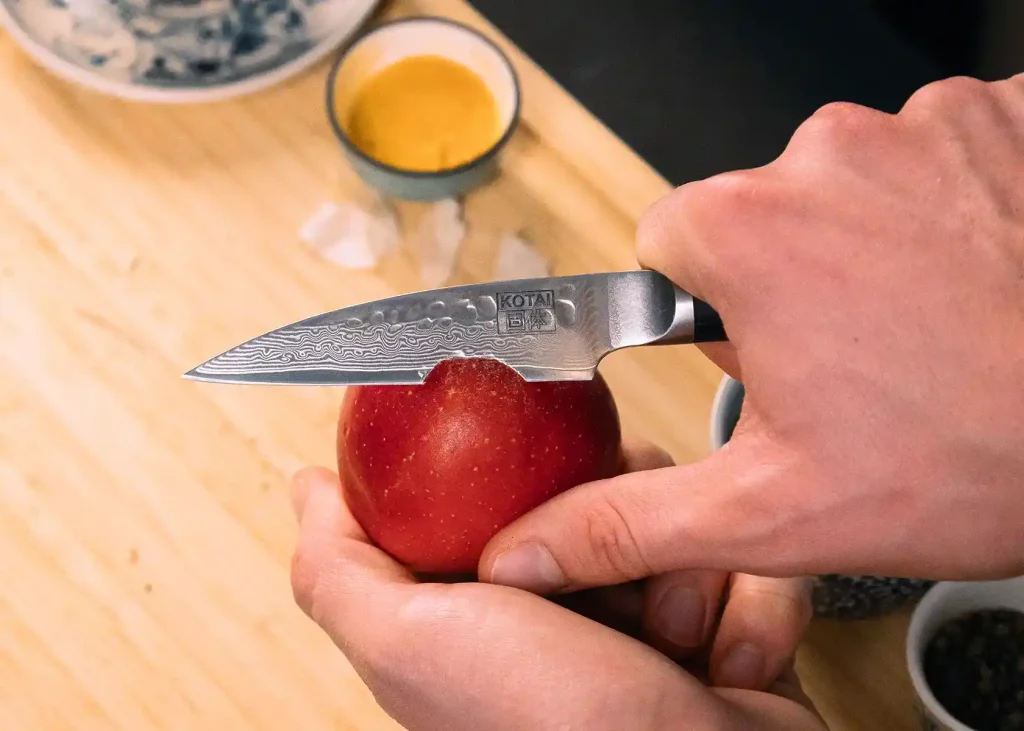
2. The Paring Knife – Precision at Its Best
Next on the list is the paring knife. While the chef’s knife can handle bigger jobs, the paring knife is your go-to for delicate, precise tasks. Typically, these knives have a blade of about 3 to 4 inches, making them ideal for peeling, trimming, and detailed slicing.
Why are Paring Knives Essential for a Chef?
- Precision: The small size and sharp blade allow you to handle intricate tasks, such as deveining shrimp or peeling fruits and vegetables.
- Control: The paring knife’s lightweight nature makes it easy to maneuver, offering you complete control over the smallest cuts.
- Compact Design: It’s easy to store and doesn’t take up much space in your kitchen, but it still packs a punch in terms of functionality.
While a chef’s knife may feel cumbersome for delicate work, the paring knife steps in to provide the finesse needed for detail-oriented tasks. It’s the perfect tool when you need to add a professional touch to your food presentation, like creating garnishes or making fine cuts for plating.
Paring Knife Example: Shun Classic Paring Knife

The Shun Classic Paring Knife is a meticulously crafted kitchen essential, renowned for its precision, durability, and exceptional design. Handcrafted in Seki, Japan, this knife exemplifies traditional Japanese craftsmanship combined with modern performance features. It is particularly ideal for peeling, coring, trimming, decorating, and other intricate detail work. Its compact size grants users precise control over the blade’s tip and edge, making it perfect for in-hand tasks rather than cutting against a board. Additionally, it handles small foods like garlic cloves and ginger with ease.
Superior Blade Composition
At the heart of the Shun Classic Paring Knife is the VG-MAX cutting core, Shun’s proprietary high-performance steel. This core is known for its wear and corrosion resistance, as well as its incredible edge retention. The blade is meticulously honed to a razor-sharp 16° edge on each side, ensuring exceptional cutting precision. To enhance its performance and durability, the blade is clad in 68 layers of Damascus stainless steel (34 layers on each side). This not only supports the core but also adds stain resistance and aids in food release from the blade, contributing to a smoother, more efficient cutting experience.
Beautiful and Functional Design
The knife’s aesthetics are just as remarkable as its functionality. The Damascus cladding is bead-blasted to create a flowing pattern, showcasing the layered steel’s beauty. This is complemented by the D-shaped ebony PakkaWood handle, which is not only visually striking but also durable and moisture-resistant. The handle is ergonomically designed for comfort, fitting naturally in both left and right hands. Its full composite tang ensures light weight and perfect balance, making it an extension of your hand for detailed tasks. Additionally, the sloped bolster and choil provide a comfortable pinch grip while simplifying cleaning.
Performance and Versatility
This paring knife shines in its versatility. During testing, it demonstrated the ability to neatly peel apples, hull strawberries, and slice through hard cheeses with ease. Its wicked sharpness and balanced design allowed for excellent control, enabling precise cuts during detail-oriented tasks. The rounded PakkaWood handle enhanced comfort, regardless of grip style, whether used as a traditional paring knife or as a utility knife for more intricate work. The knife’s high-quality steel maintained its razor-sharp edge throughout extensive use, effortlessly removing strawberry stems and slicing through firm cheeses without dulling.
Shun Classic Paring Knife User Feedback and Reviews
Customers consistently praise the Shun Classic Paring Knife for its exceptional sharpness, lightweight feel, and balanced design. Users appreciate the blade’s thinness and durability, highlighting how effortlessly it slices through small fruits and vegetables. Many reviewers also note the knife’s stunning appearance and high-quality craftsmanship, emphasizing its value as an investment piece. Several users mentioned that the lifetime free sharpening service provided by Shun adds significant value, ensuring the knife remains sharp for years. While the price is higher compared to other brands, most customers agree that the performance, durability, and aesthetics justify the cost.
Thoughtful Design Features
- VG-MAX Cutting Core: Provides exceptional edge retention, wear, and corrosion resistance.
- 68-Layer Damascus Cladding: Enhances stain resistance and facilitates food release.
- 16° Cutting Edge: Razor-sharp edge on each side for precision cutting.
- D-Shaped PakkaWood Handle: Durable, beautiful, and comfortable for both left and right-handed users.
- Full Composite Tang: Ensures perfect balance and lightweight feel.
- Handcrafted in Seki, Japan: Merges traditional Japanese craftsmanship with modern technology.
- Lifetime Free Sharpening: Offered by Shun to maintain optimal sharpness over the knife’s lifespan.
Considerations and Drawbacks
The primary downside noted by users is the premium price, which is approximately 40% more than comparable brands, such as the Mac paring knife. However, those who frequently work with fruits and vegetables or enthusiasts who appreciate high-quality cutlery find the investment worthwhile. The knife’s longevity and consistent performance make it a preferred choice among professional chefs and home cooks alike.
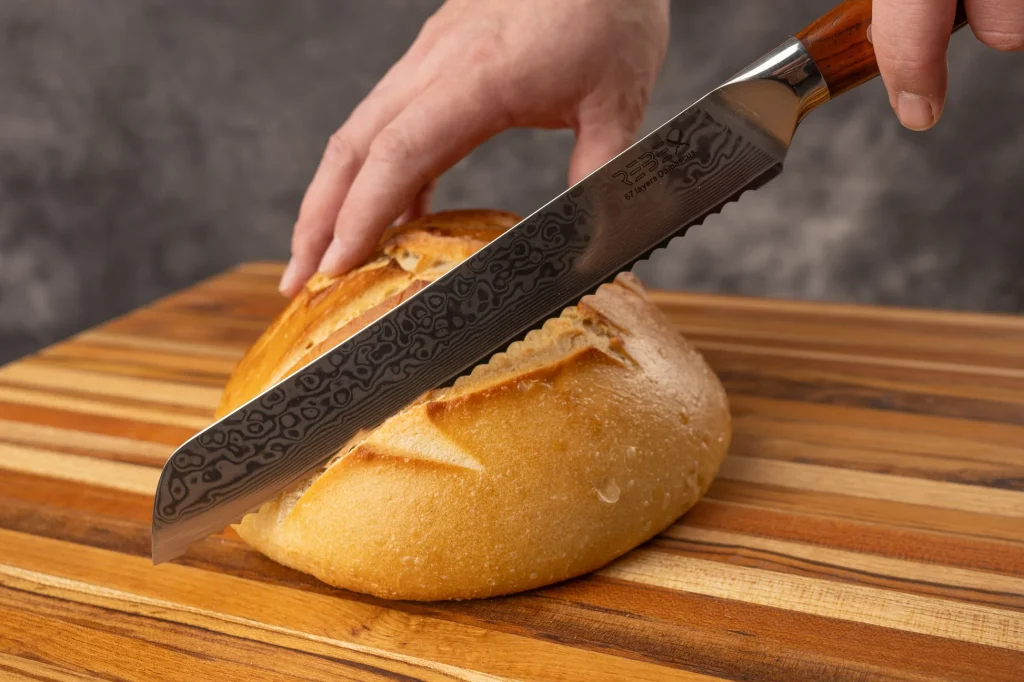
3. The Serrated Bread Knife – Cutting Through Tough Exteriors
Rounding out the list is the serrated bread knife. This knife is often overlooked but plays a critical role, especially when it comes to cutting through foods with tough exteriors and soft interiors. The blade of a bread knife typically ranges from 8 to 10 inches and features a saw-like edge that easily slices through crusty breads and delicate cakes without tearing them apart.
How Essential is a Bread Knife to a Chef?
- Perfect for Breads and Cakes: Its serrated edge grips and cuts through hard surfaces without crushing the soft insides, making it a must for anyone who loves baking.
- Versatility Beyond Bread: In addition to bread, this knife works wonders on other tough-skinned foods like tomatoes and citrus fruits.
- Effortless Cutting: Its design requires minimal force, making it easier on your hands and wrists, especially for extended use.
If you’ve ever tried to cut a fresh loaf of bread with a regular knife, you know how frustrating it can be. A serrated bread knife is the solution, gliding through both delicate and tough textures with ease. It’s also a great choice for foods that have both soft and hard layers, making it more versatile than its name suggests.
Example Bread Knife: Tojiro F-737 Bread Slicer

The Tojiro F-737 Bread Slicer stands out as one of the most recommended and highly-rated bread knives available, earning its top spot after extensive testing and user feedback. Crafted by Tojiro, one of Japan’s most respected knife makers, this tool combines high-quality materials, ergonomic design, and precise functionality to deliver a seamless cutting experience for bread enthusiasts.
Slicing Performance: Clean, Effortless Cuts
This bread knife excels in its ability to slice through even the most challenging breads without causing the typical mess or squishing that lesser knives may produce. The wave-style serrations glide through hard crusts while maintaining the integrity of the soft inside. It handles everything from fresh baguettes to hearty sourdough loaves with ease.
Many users report slicing bread as a “fun” and “effortless” experience, with feedback describing the knife as incredibly easy to use. Its flexibility and sharpness ensure that slices are uniform, whether you’re cutting into a soft loaf or tackling a tough crust.
Durability & Maintenance
Despite being lightweight, the high-carbon stainless steel blade of the Tojiro F-737 is sturdy enough to maintain sharpness for long periods. Several users have praised the knife for retaining its edge after extensive use, reporting that it continues to cut smoothly and cleanly without needing frequent sharpening. Even those who have used the knife daily have commented that it still performs like new, with no visible dulling or significant wear on the blade.
Key Features & Specifications
- High-Carbon Stainless Steel Blade: The 235mm blade (9.25 inches) of the Tojiro F-737 is made from high-carbon stainless steel, offering both rust resistance and durability.
- Wave-Style Serration: The serrated edge ensures clean cuts through a variety of bread types, from dense sourdough loaves to soft sandwich breads, minimizing tearing or squishing.
- Natural Wood Handle: The knife features a natural wood handle for a comfortable grip and aesthetic appeal, contributing to its lightweight feel.
- Overall Length: The knife measures 375mm (14.75 inches) in total length.
- Weight: At only 110 grams, it’s lightweight and easy to maneuver.
These elements come together to offer a high-performance bread knife, designed to make slicing bread both effortless and precise.
User Reviews: What People Are Saying
A majority of reviews highlight the effortlessness of using this knife. Many have noted that it glides through bread with ease, producing clean, precise slices every time. Below are some key user insights:
- “The best bread knife I have ever used”: Several reviewers called it the best bread knife they’ve owned, praising its sharpness and comfort in the hand.
- “Cuts through bread like a hot knife through butter”: Many users, including professional chefs, loved how smoothly the knife slices through bread without crushing the interior.
- “Great for a variety of tasks”: Some users have also found it useful for cutting other foods, such as cakes and tomatoes, thanks to its versatile serrated edge.
- “Lightweight and sharp”: Customers appreciate the knife’s light feel and ability to stay sharp, even after heavy use.
However, there have been a few caveats to note. Some users with larger hands find the handle a bit small, but this hasn’t detracted from its overall effectiveness for most users.
Choosing the Right Knife for Your Needs
While these essential knives form the backbone of any kitchen, there are some additional factors to consider when purchasing them. Not all knives are created equal, and investing in the right one for your cooking style will take your skills to the next level. Here’s what to keep in mind:
- Material: Look for knives made from high-carbon stainless steel, as they are durable, rust-resistant, and easy to sharpen.
- Handle Comfort: You’ll want a knife that feels good in your hand. Ergonomic handles, especially those made of wood or polymer, are typically the most comfortable for prolonged use.
- Balance and Weight: The best knives offer a balance between the blade and the handle. A well-balanced knife is easier to control and makes cutting feel more natural.
How to Care for Your Knives
Once you’ve invested in these set of chef knives, it’s important to maintain them properly so they last for years to come. Regular care will keep your blades sharp and your cuts clean, helping you make the most out of your investment.
Knife Maintenance Tips:
- Sharpen Regularly: A dull knife is more dangerous than a sharp one, as it requires more pressure and increases the chances of slipping. Invest in a good sharpening tool or have your knives professionally sharpened once a year.
- Hand Wash Only: Avoid putting your knives in the dishwasher, as the high heat and harsh detergents can damage both the blade and the handle. Instead, wash them by hand with warm, soapy water, and dry them immediately.
- Store Properly: Never throw your knives in a drawer unprotected. Use a knife block, magnetic strip, or protective sheaths to keep the blades from dulling and prevent accidents.
Taking care of your knives not only prolongs their lifespan but also ensures that they perform at their best. A well-maintained knife is a chef’s most trusted companion in the kitchen.
The Perfect Trio for Every Chef, Professional and Home!
In summary, the 3 essential knives for chefs are the chef’s knife, the paring knife, and the serrated bread knife. Together, they form the foundation of any well-equipped kitchen and will allow you to tackle a wide variety of cooking tasks with ease.
Important Chef Knife Recap
- The chef’s knife is your versatile go-to for almost any job.
- The paring knife brings precision and control to finer tasks.
- The serrated bread knife handles tough surfaces and soft interiors effortlessly.
By investing in high-quality versions of these knives as a chef, you’re setting yourself up for success in the kitchen. Whether you’re preparing a delicate salad, slicing into a perfectly crusty loaf of bread, or trimming meat with finesse, these knives will be your most reliable tools. Once you experience the ease and precision they bring to your cooking, you’ll wonder how you ever managed without them.
Essential Chef Knives Final Thoughts
Having the right knives in your kitchen not only makes cooking more enjoyable, but it also ensures that you can tackle any culinary challenge that comes your way. While there are many knives you could add to your collection, starting with these 3 chef knives gives you a solid foundation for all your culinary endeavors.
Ready to take your cooking skills to the next level? Invest in these three must-have knives, maintain them well, and watch your efficiency and precision soar. No matter what dish you’re creating, you’ll be fully equipped to handle the task with ease and confidence.

